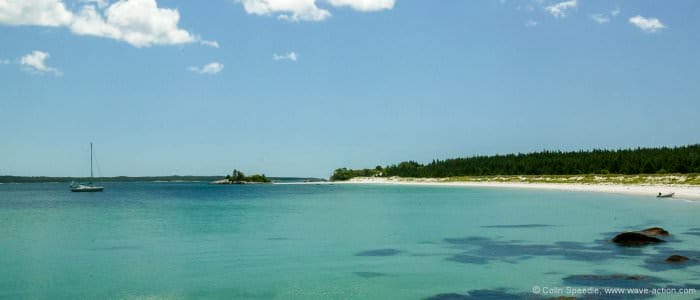
Having caught up on some rest at peaceful McNutt’s Island, it was time to load up on supplies and settle down to a season’s cruising.
As just up the inlet lies the historic town of Shelburne, we had a perfect opportunity to refuel and replenish right on our doorstep, so early one morning we made tracks up to the town, picking up a mooring off the super-friendly Shelburne Harbour Yacht Club.
Many of the buildings on the waterfront date back to the late 1700’s when the town was a loyalist stronghold. A number of these have been preserved as museum buildings that give an insight into the life, times, and commerce of the town.
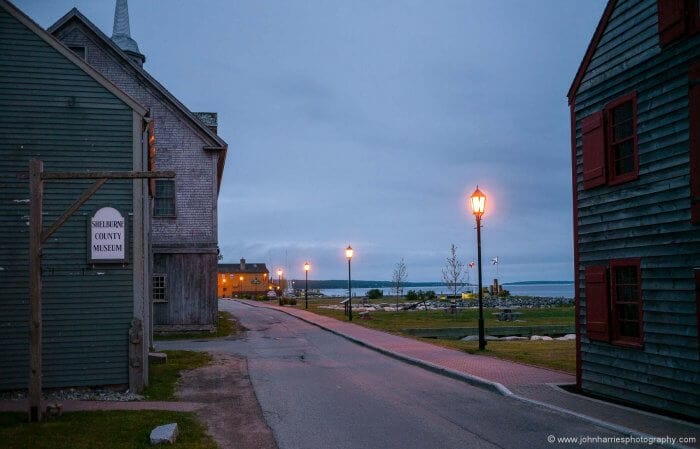
It’s a handsome, tranquil, leafy enclave which, far from being preserved in aspic, remains a fully functioning town with a wide range of services. There’s also an excellent restaurant tucked away in a side street where, feeling flush for once, we savoured a fine meal.
And at the yacht club we enjoyed meeting the local members and the crews of other visiting yachts from Britain, Sweden and Iceland. The club is the first stop in the province for taking on fuel alongside, and so attracts a lot of first-time visitors arriving from the south—yet another good reason to include Shelburne in your itinerary.
An Involuntary Visitor
Down at the extensive government pier lay a sizeable and impressive oil rig support vessel, but what caught my eye was the aging, blackened hulk on the inside of the wharf. When puttering by in the dinghy, the name on the bow, Farley Mowat, caught my eye and triggered my memory:
This was the old Norwegian fisheries research trawler bought by the controversial Sea Shepherd Conservation Society to be used as their flagship vessel, named after their one-time International Chairman and benefactor, Canadian writer Farley Mowat.
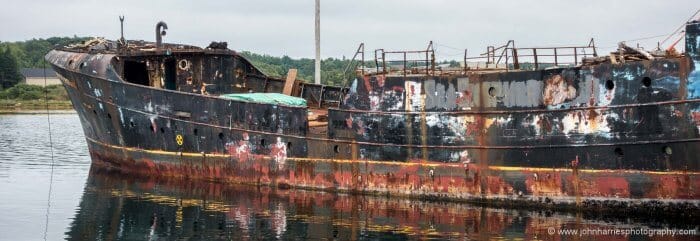
In 2008 the ship was seized by Canadian authorities for approaching too close to the annual seal hunt, since when it has been all downhill for this once proud vessel.
Sold on two occasions to help pay off accrued berthing fees amounting to hundreds of thousands of Canadian dollars, towed from one reluctant harbour authority to another, stripped of everything of value, trouble has continued to dog the old ship.
In 2015 she (perhaps predictably) sank at her berth in Shelburne and had to be raised and have 2,000 litres of pollutants pumped out of her—at yet more cost. Still mired in legal issues over monies owed and responsibility for her future, she is now clearly way beyond repair, but remains a costly eyesore on the Shelburne waterfront.
It might be hard to see it now but she was once a fine ship, ice-strengthened and built to face the worst the high North Atlantic could throw at her. On the day she was launched there would have been flags and champagne and happy families celebrating a bright future for her and those who sailed in her.
Now all that awaits is the final coup de grace of the cutting torch, and it seems a desperate shame that some more positive use couldn’t have been found for her or for all of the money that was wasted long before she reached her current state.
Out Into The Murk
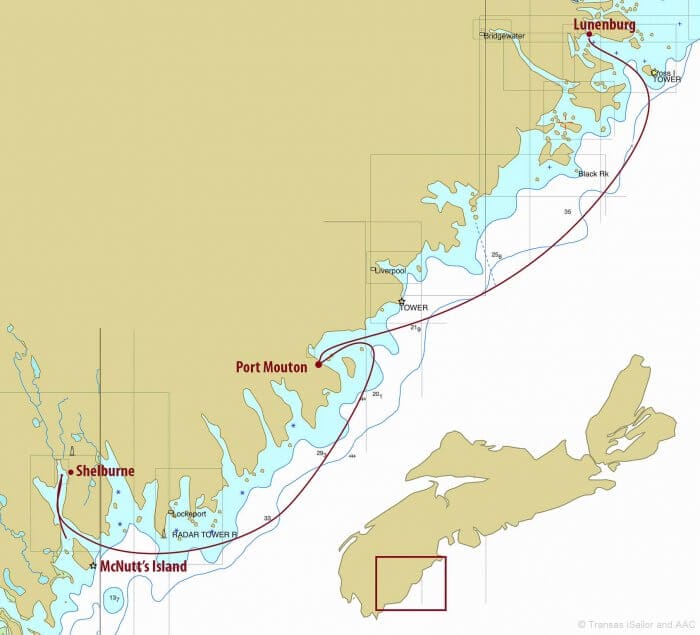
Although the sun was shining brightly the morning we left Shelburne, we weren’t fooled that we’d escaped the fog. We know that it’s often the case that the visibility is perfect up such a long inlet but down at the entrance you won’t be able to see your hand in front of your face. And so it was.
But you won’t get far if you hang around here waiting for a clear day this early in the season and, as we’re used to such limited visibility, we weren’t turning back. So we checked the radar and the AIS and off we went towards Port Mouton to the east.
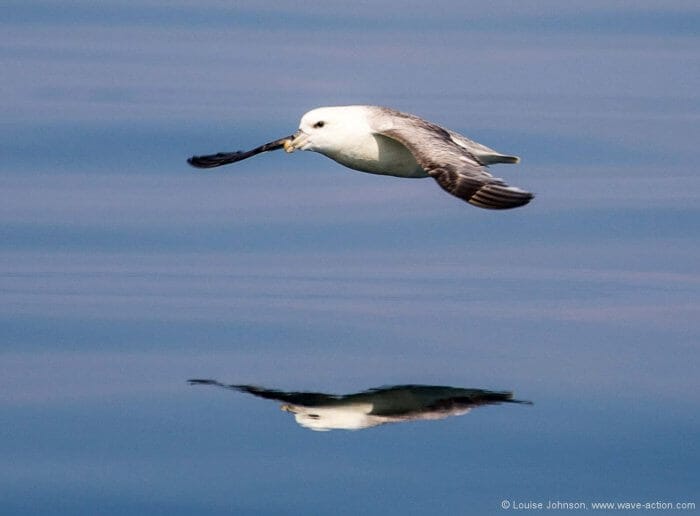
Fog is often accompanied by wind in these latitudes, and we were enjoying a fresh breeze as we sped along the coast, keeping well away from any dangers close inshore. As far as we could see the only living things out on the water were a few shearwaters and fulmars; ghostly presences that occasionally swooped into our cocoon-like aura.
By the time we reached the approaches to Port Mouton, our eyes were beginning to feel the strain of staring into the radar all day, and we were looking forward to getting in and our anchor down.
But we figured that we still faced a long, slow slog to reach our preferred anchorage off Carters Beach, as the pilot book spoke of small fishing vessels in and around the entrance. However, by the time we were halfway up the channel, the sun appeared over our heads, and moments later we sailed out of the tunnel of fog into a bright, clear day. Perfect!
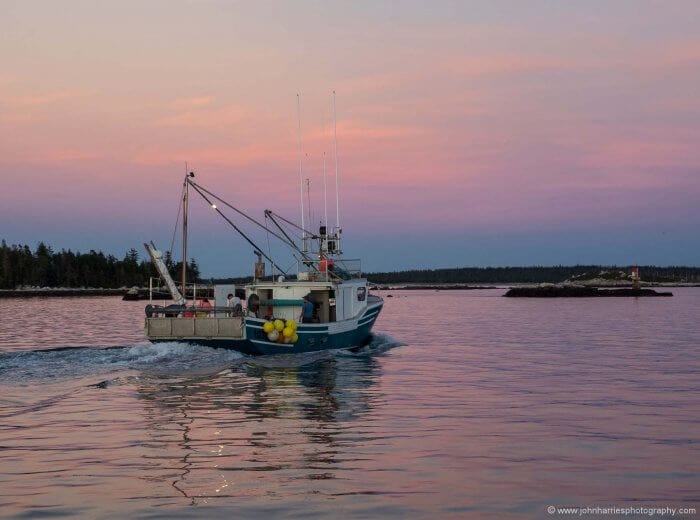
Wiped out from a tiring passage, we simply dropped the hook off the first inviting looking beach and settled down for the night, well off the route of any fishing vessels heading in to Port Mouton further up the inlet. Enveloped in total peace we slept the sleep of the dead.

In the morning, though, we were troubled to find that there was a small car park at the head of the beach, a tiny blemish that marred our otherwise perfect view. That certainly wouldn’t do, so we upped our anchor and headed around the corner into the next bay.
The Joy Of Discovery
Lou and I have been spoilt, having spent so much time sailing in the glories of Scotland. This has made us somewhat picky when appraising anchorages: Is it as spectacular as Mingulay, as snug as Wizard Pool, or as wild and elemental as Loch Scavaig?
All of which makes it very hard for other places to measure up, let alone meet such high standards—it’s probably not the smartest thing to do. But as the only boat in the anchorage on a beautiful sunlit morning, without a soul on the beach or the noise of any infernal combustion engine to disturb the peace, we had to agree that Carters Beach compared very favourably indeed with some of our all-time favourites.
This is the sort of place that makes you unwilling to start the outboard motor, so out came the paddles and ashore we went.
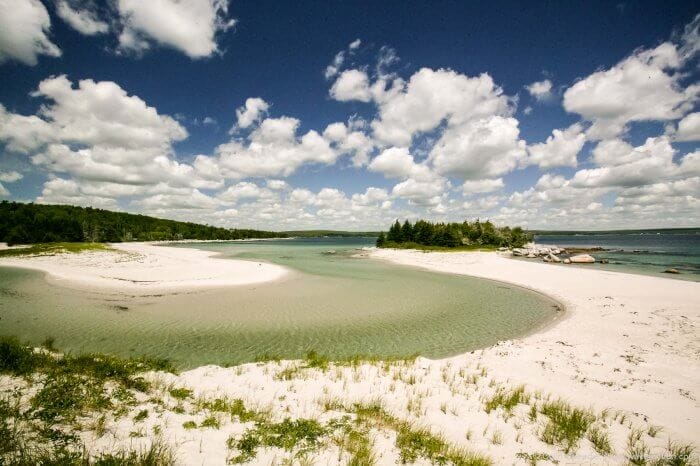
I suspect there’s a little of Captain Cook in all of us who go long distance cruising, and the discovery of such a pristine spot always hits the mark in a special way, allowing us the illusion of being the first to set foot on a deserted and undiscovered shore. After so long in ‘civilization’ it makes for a magical, memorable, fun moment in any cruise.
This was no exception. Clear blue water lapped against a white sand beach, backed by a flower-filled dune system, fronting forest and an idyllic small wetland area.

Of course, the fantasy couldn’t last long. Other seekers after peace and solitude, hikers and kayakers, ‘discovered’ the beach too, but fortunately the special nature of the place worked its soothing magic and kept us all on our best behaviour.
So we passed three wonderful days and nights in perfect conditions, exploring and enjoying the company of watchful seals that swam stealthily by, peering at the strange metal interloper that had taken up residence in their bay.
We’d traveled a long way to find such a place and were determined to enjoy every moment of it—and we did.
If You Have To Move…
We find that the ideal comedown to preserve such a perfect moment is to immerse yourself in the opposite—a bright and busy place. Fortunately for us, Lunenburg was right around the corner to meet that need, so when we finally, reluctantly, left Carters Beach, that’s where we headed.

We’re normally more than a little ambivalent about ‘must-see’ places, which we often find trade off their reputation and get their pricing policy out of the “Gouger’s Handbook”.
We’re also more than a little cagey about picking up moorings in strange places, as the owner’s boundless optimism about the holding capacity of a modest concrete block will not always withstand the acid test of 15 tonnes of aluminum snatching away at it like a bull terrier when the wind gets up. Given the choice we’ll always anchor.
With several days of fresh winds forecast we were disappointed to find that, as in so many other popular places, all of the best spots to anchor were now occupied with moorings. Fortunately we managed to secure a mooring with a good pedigree from a local boatyard, which allowed us to go ashore in a relaxed mood to explore the town.
Looked at from the mooring, Lunenburg reminded us a lot of our home port of Falmouth in Cornwall: The waterfront; the colourful houses rising up the hills; the restaurants, bars and quirky shops ashore. Also like Falmouth, Lunenburg has a terrific maritime museum, not to be missed.
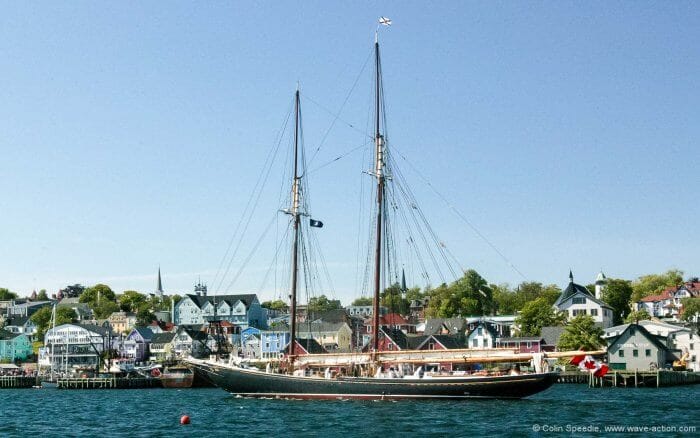
And, of course, Lunenburg is famous for wooden boats, for this is an area where the saw and the adze still hold sway over the resin pot and the welding kit. Looking around the harbour at schooners and gaff rigs made us feel right at home.
When the lovely Bluenose II returned to her berth after a cruise up the coast, all eyes were upon her. I sometimes wonder whether non-sailing onlookers realise that such a perfect blend of form and function came together in a vessel designed for use in the dirty, hard and sometimes deadly trade of the Grand Banks cod fishery, not as a gentleman’s summer plaything.
Or, that far from being the lucky accident of some draughtsman’s pencil, she was born of centuries of finely-honed craftsmen’s skills that combined to make practical, working art that best suited the tough sea conditions of the area.
That we restore, rebuild, and maintain such vessels for modern generations to see is not only a fitting tribute to the generations of those who created and worked them, but also in recognition that they represent a whole range of skills that we have come perilously close to losing altogether.
Who knows but one day we may need these skills again.

Hi Colin,
Another wonderful piece of writing and great pics. Thanks.
Farley Mowat would have been amused and then written something both poignant and amusing about the travels and fate of his namesake ship.
For those not introduced yet to this prolific and varied author, let me say that he has written one of the drop dead funniest books about sailing, “The Boat That Wouldn’t float, one of the best war books, “And No Birds Sang”, a non-fiction true-adventure book from the logs of a Halifax salvage trawler around WWII, “Grey Seas Under”, and many books about the peoples and life in high latitudes among many other subjects. Some might remember his “Never Cry Wolf” (book & film.) He was an “outdoor” writer, a true “environmental writer” before that was a common description. Of the numerous books I have read over the decades, all three of the above would be on or close among my top 100. He is one where the phrase “They broke the mold with him” aptly fits.
My best, Dick Stevenson, s/v Alchemy
Hi Dick,
I would second your enthusiasm for Farley’s books. As an aside, one of my closest friends—and crew for many thousands of miles in the Arctic on MC—bought a house from the same two brothers that sold Farley the schooner. My friend tells many fun stories of living in and fishing out of the real “Muddy Hole” (it’s not called that), and he even wrote a novel set there, called The Second Trap.
A great read, but sadly out of print now.
Hi Dick and John
thanks for the heads up on Farley Mowat’s books, as I can only remember reading one of his books ( a Whale for the Killing) many years ago. As we’re off to Newfoundland next year, that’s something I’ll make sure to put right when we’re ‘in country’, where (no doubt) his writing will resonate even more deeply.
Best wishes
Colin
Just an aside here, as it’s hard to top the degree of Canadian found in the fact that my wife’s late grandmother, of Belleville, Ontario, babysat Farley Mowat in the early 1930s. I met the woman, and she said he was “trouble” even at that early stage!
On a side note, Colin, I notice you have a foretriangle radar reflector in use while anchoring. Do you also use an anchoring dayshape? Dayshapes are very rare on the Great Lakes, but are very customary in European waters, so I’m wondering which way the Nova Scotian custom goes. Nice writing, by the way.
Hi Marc
it’s actually an anchor ball, and we always use it. In our busy home waters they are a must and it’s worth bearing in mind that in the event of a collision that might not ostensibly be your fault, if you’re not displaying the correct day shape you will be held (at least) partially to to blame. As a long standing commercial skipper I know this and have nowhere to hide if it happens, so – up it goes. And I’m glad you liked the writing – thanks.
Colin
Hi Marc,
I don’t think I have ever seen an anchoring day shape (black ball) in use anywhere on the North American East Coast, except occasionally by Brits and Europeans, who are generally better at this sort of thing than we are.
That said, we carry said day shape and used it extensively in British waters for just the reason Colin states.
Colin/John: Limited as my European water-watching is, that reflects my experience also. I don’t really grasp why that is that day shapes are barely used here and are barely understood when they are seen. Intent is hard to determine under certain conditions otherwise. Speaking of which, I noticed while in French waters on an RYA course that the VHF was nearly silent, and when it was heard, the calls were far more tense and I dare say professional sounding. The contrast to the idle chatter, even on 16, on this side of the water is considerable.
Hi All,
With regard to day signals, use in the UK, the rest of the EU and the Med is not ubiquitous, but really common. I display as SOP. Casual dockside conversations in years past led to the observation that the US is the only (?) place in the world with “designated” anchorages where a day signal was un-necessary. This led to day signals not being used in general. Please regard this as a maritime myth until proven otherwise. Although, if back in the US and anchored in some out of the way place, I might use a day signal, especially if traffic was around.
I also use day signal indicating motoring when sails are up.
My best, Dick Stevenson, s/v Alchemy
I haven’t seen an anchor ball used much on the US Eastern shore either. However, it is required outside of the designated anchorages. This is the exception (Rule 30):
g) A vessel of less than 20 meters in length, when at anchor in a special anchorage area designated by the Secretary, shall not be required to exhibit the anchor lights and shapes required by this Rule.
There is also an exception for vessels under 7m, but that’s not most cruising boats.
That said, even if most people don’t use it, as Colin said, it would likely be a factor in a court’s liability ruling.
Robert
Thank you Colin, just felt as if I had been on the boat with you. Wonderful article 🙂
Thank you, Ernest, I’m glad you enjoyed it.
Well done Colin. We’ve cruised the area and you captured it perfectly. We look forward to going there again.
Thanks Gino. We’ll look forward to seeing you up here!
Hi Colin,
All three are wonderful places that we have really enjoyed. To me, one of the best parts about cruising Nova Scotia is the favorable shore access provided by the law there. Carter’s Beach is lovely and incredible to me largely because of how unexpected it is but the islands that you are anchored behind are even more interesting to explore to me.
Eric
Eric, I couldn’t agree more. It saddens me when we visit places where every single foot of water’s edge has a ‘Private!’ sign. It’s not as if there are millions of us cruisers looking to vandalise the shoreline, now, is it? Sadly this is a creeping sickness in far too many parts of the world, so well done Nova Scotia for resisting this trend so resolutely.
Colin
Hi Eric,
Sadly, I don’t think we actually have any shore access law per se in Nova Scotia and easy shore access is probably more about low population density rather than law. As I understand it, common access to private waterfront only applies below the high water mark. That said, I believe the law and practice governing trespass is more restrictive on the land owner than it is in most US states.
Any lawyers out there with knowledge?
Personally, I would like to see Canada look toward laws based on UK Rights of Way, before it’s too late.
Hi John,
Having cruised most of the east coast of the US, often with dog & children who were desperate to get ashore, let me second and extend your wish to have the shoreline become more open to visit to the US as well. My 10 years now cruising in the Med and Northern Europe have been far far more enjoyable by the “right to roam” rules which generally prevail and allow not only access to shoreline, but make for tramping around the countryside wonderful for those of us who like to wander and just see where we get to.
My best, Dick Stevenson, s/v Alchemy
Hi John,
It is funny how perspective can change ones view of this so much. I believe that you are correct about it only being below the high water mark. For someone whose home cruising grounds (US) don’t even allow access below the high tide line, the law in Nova Scotia is wonderful. That said, Dick’s description of the Med and Northern Europe sounds even better.
Eric
On the subject of Farley Mowat books, I highly recommend “The Serpent’s Coil”. No sailing, just a chronicle of some incredible endurance and seamanship on Foundation Marine, coal-powered salvage tugs, an aging Liberty ship, and a hurricane that wouldn’t die. Near the top of my all-time favorites list.
Now added to the list – thanks!
Hi Marcus,
Thanks for the suggestion. It is one I have missed and sounds a bit like “Grey Seas Under”.
Dick
Hi Colin…you are very welcome. I predict it will become one of your favorites as well.
Hi Dick… I am trying to recall if I have ever read “Grey Seas Under”. I know I have seen that title mentioned. Sounds worthwhile to track it down. “The Serpent’s Coil” relates the purchase of the first Foundation Marine tug, the Scottish built “Josephine”, if my memory serves correctly, from a backwater in England or perhaps Germany. The story recounts a Liberty ship sailing from England, in gravel ballast, bound for a U.S. port. She is abandoned at sea after the ballast shifts during it’s first encounter with the storm. She was listing at around 45* and the crew were unable to right her. That’s all you get… I guarantee you will love the story!
Hi Marcus,
Thanks for the teaser. Sounds typical FM who could take any subject and make it well worth reading.
“Grey Seas Under” is taken from the logs of the coal powered salvage/tow vessels that worked out of Halifax during and around WWII. Their “nice” day was 40F/5C, sleety and blowing F6 and they would range as far as Bermuda, if memory serves. I remember (with dis-belief at the time) that many of their rescues/tows were of these huge cargo and war vessels that were so thrown around in the seas that the prop came out of the water and the ship lost propulsion. Amazing men. Amazing vessels.
Enjoy, Dick
Hello again, Dick…
One final tidbit and I promise to shut up. After getting the hell kicked out of them, the crew made it back to Halifax with literally nothing but dust in the bunkers. They immediately re-bunkered and put to sea on another salvage job. Amazing ships and men, indeed! Positively humbling!
The book was rescued from a public library “cull” bin in Tampa, FL, by a landlubber acquaintance who knew of my passion for all things maritime.
Dick, I reviewed this book in my “sea books” blog. It may be of interest to those unfamiliar with Mowat’s works: http://volumesofsalt.blogspot.ca/2011/05/tale-to-tug-at-heartstrings.html
Yeah, Farley Mowat ! “The Boat Who Wouldn’t Float” is the funniest book that I know and it is one of the reasons for my “deviation” to Newfoundland. Just follow his description of the making and effect of “Screech”, the Newfie rum. I’m glad though, to find that he was exaggerating in some respects as I found a clear sky in Trepassey, the place where “the fog is made”.
“A Whale for the Killing” is a great read also, although it holds a bitter note. I heard this book was the reason that the Newfies drove him out of Newfoundland by social pressure.
Hans, one thing we often noted on the east coast of the USA and Canada is how the local slang that we grew up with has crossed the ocean. ‘Screech’ was rough cider where I grew up, also known as ‘electric lemonade’ and was the sort of stuff you could stand a spoon up in!
Colin
Hi Colin,
Ah yes, hard cider, called scrumpy where I went to school in Devon. Lethal stuff that could get you puking-plastered for five shillings—as a certain young lad discovered to his long-remembered shame.
Five shillings! That would have bought you about 5 gallons of the stuff – no wonder your ‘friend’ was sick!
He might have encouraged a few friends into the same state.
Beautifully written and illustrated … better than a cruising guide for three our our most favorite anchorages in SW Nova Scotia, Fascinating story about the Farley Mowat, the man and the ship. As a writer he captured the essence of the maritime traditions and people of that region … makes we want to reread his great books. THANKS!
It’s a pleasure, Doug, and thanks to you for the kind words. Looks like there’s going to be a small scale run on Farley Mowat’s books, which can only be a good thing.
Colin
Thanks for your descriptions Colin – they bridge distance!
One part resonated for me though – that unique feeling of isolation, where any disturbance to the natural surrounds seems as abhorrent as littering the land, or polluting the water. In NZ we have the Mount John observatory in Tekapo, where the night sky is an internationally recognised reserve and there are strict bylaws controlling lights in the surrounding countryside to preserve the natural darkness.
I wonder if we need “stillness” reserves, areas that protect with bylaws (can’t believe I am writing that) to save the unique qualities of some of these areas before they are lost to un-knowing world of portable deck-generators and other “necessities” of modern life.
Rob
Hi Rob,
I echo your wish for “dark” preserves and, in fact, they are starting to grow. We encountered a few last year (Shell Point in N Florida and Big Bend Nat’l Park in Texas) and sailed to Sark where the whole island attempts to be as dark as possible (one of the The Channel Islands). Even though I have had the privilege of seeing the night sky offshore, one forgets how much is obliterated when you get near civilization. Most, unfortunately, do not have a clue what they are missing.
My best, Dick Stevenson, s/v Alchemy
Hi Rob and Dick
‘light pollution’ as its sometimes called distances us from the magic of the night skies. As a child I listened in wonder as my mother taught me the basics of navigating my way around the planets and constellations, something I fail pitifully at today – but then she had grown up in an era when street lighting was in inner city luxury. And it has harmful effects on the natural world, too, such as driving female turtles away from nesting beaches. Personally I think it’s time to turn the lights down and reclaim the night skies as a necessary part of reclaiming our sense of belonging amidst nature.
And I can second Dick in loving Sark, a lovely little island with much charm – and darkness!
Best wishes
Colin
Hi Colin, Rob, Dick,
I’d also add the need to reduce ‘noise pollution’ to reclaim our connection to nature. A dark evening with only natural sounds is an amazing experience that everyone should be able to enjoy. In the US, the National Park Service has a group dedicated to this, the “Natural Sounds and Night Skies Division.” Of course, nothing will happen unless we, the people that have experienced this first hand, help others to understand the importance and pressure our governments to take action.
For me, the downside is the hit to the wallet since dark skies and natural soundscapes prompt the purchase of telescopes and microphones!
Robert
So lovely to now read about those long summer days of exploration in Nova Scotia, now that we’re tucked up with log fires and thick sweaters over winter months! I’ll never forget our time in and around the beautiful Port Mouton area, for many reasons… not only sailing through that impenetrable fog in the approaches with the wind rising incessantly around us, but the meditative calm once inside, with the wonderful shallows, white beaches, sand dollars and raccoon footprints in the sand!